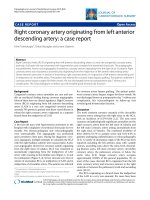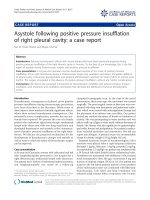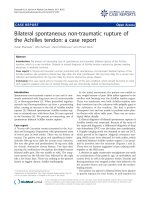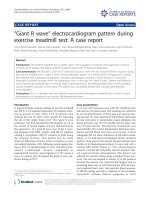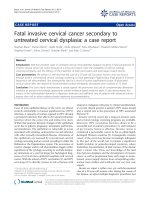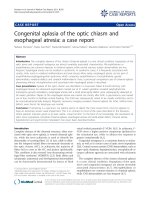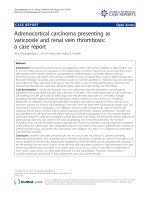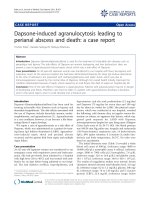Báo cáo y học: " Human herpes virus 8 replication during disseminated tuberculosis in a man with human immunodeficiency virus: a case report" pdf
Bạn đang xem bản rút gọn của tài liệu. Xem và tải ngay bản đầy đủ của tài liệu tại đây (217.28 KB, 5 trang )
BioMed Central
Page 1 of 5
(page number not for citation purposes)
Journal of Medical Case Reports
Open Access
Case report
Human herpes virus 8 replication during disseminated tuberculosis
in a man with human immunodeficiency virus: a case report
Sarra Inoubli
1
, Laurence Toutous-Trellu
1
, Gieri Cathomas
2
,
Eric Oksenhendler
3
, Bernard Hirschel
1
and Emmanuelle Boffi El Amari*
1
Address:
1
Département des maladies infectieuses, Hôpital Cantonal Universitaire de Genève, Genève, Switzerland,
2
Kantonales Institute für
Pathologie Liestal, Liestal, Switzerland and
3
Département d'Immunologie Clinique, Hôpital Saint-Louis, Paris, France
Email: Sarra Inoubli - ; Laurence Toutous-Trellu - ; Gieri Cathomas - ;
Eric Oksenhendler - ; Bernard Hirschel - ; Emmanuelle Boffi El Amari* - boffi-
* Corresponding author
Abstract
Introduction: Human herpes virus 8 (HHV-8) is mainly responsible for the development of Kaposi's sarcoma and
multicentric Castleman's disease in immunocompromised patients with untreated human immunodeficiency virus.
Positive viral loads have been described in cases of Kaposi's sarcoma and multicentric Castleman's disease, with higher
values found in the latter. We describe the case of a patient with HIV in whom a high level of HHV-8 replication was
detected and who contracted an opportunistic disease other than multicentric Castleman's disease or Kaposi's sarcoma.
Case presentation: A 25-year-old man of West African origin with HIV complained of asthenia, weight loss, fever, and
abdominal pain. Physical examination revealed that the patient had adenopathies and hepatosplenomegaly, but no skin or
mucosal lesions were seen. Our first presumptive diagnosis was disseminated tuberculosis. However, since the cultures
(sputum, bronchoalveolar lavage, blood, urine and lymph node biopsies) for mycobacteria were negative, the diagnosis
was expanded to include multicentric Castleman's disease which was supported by high HHV-8 viral loads in the patient's
blood: 196,000 copies/ml in whole blood, 39,400 copies/ml in plasma and 260 copies/10E5 in peripheral blood
mononuclear cells. However, the histology and positive polymerase chain reaction assay for Mycobacterium tuberculosis
complex of a second lymph node biopsy enabled us to conclude that the patient had disseminated tuberculosis and we
started the patient on antituberculosis treatment.
We analyzed the HHV-8 deoxyribonucleic acid in two other plasma samples (one from six months earlier and the other
was 10 days after the positive test) and both yielded negative results. A search for latent and lytic HHV-8 antibodies
confirmed that the patient was seropositive for HHV-8 before this episode.
Conclusion: We describe the case of a patient with HIV who tested positive for asymptomatic HHV-8 replication during
an opportunistic disease suggestive of multicentric Castleman's disease. The initial analysis was nullified by the diagnosis
of a disease that was unrelated to HHV-8. This case report underlines the need to clarify the full clinical meaning and
implication of a positive HHV-8 viral load in patients with AIDS. The diagnosis of multicentric Castleman's disease needs
to be studied further to determine its sensitivity and specificity. Finally, when faced with the dilemma of urgently starting
chemotherapy on a patient whose condition is deteriorating and whose clinical presentation suggests multicentric
Castleman's disease, high HHV-8 viral loads should be interpreted with caution and histological analysis of lymph nodes
or liver biopsies should be obtained first.
Published: 9 November 2009
Journal of Medical Case Reports 2009, 3:113 doi:10.1186/1752-1947-3-113
Received: 17 December 2008
Accepted: 9 November 2009
This article is available from: />© 2009 Inoubli et al; licensee BioMed Central Ltd.
This is an Open Access article distributed under the terms of the Creative Commons Attribution License ( />),
which permits unrestricted use, distribution, and reproduction in any medium, provided the original work is properly cited.
Journal of Medical Case Reports 2009, 3:113 />Page 2 of 5
(page number not for citation purposes)
Introduction
Human herpes virus 8 (HHV-8) is associated with the
development of Kaposi's sarcoma (KS) and multicentric
Castleman's disease (MCD) mostly in immunocompro-
mised patients with untreated human immunodeficiency
virus (HIV). MCD is an atypical lymphoproliferative dis-
ease characterized by systemic symptoms that include
fever, weakness, severe weight loss, generalized lymphad-
enopathy and hepatosplenomegaly. The pathological
examination of lymph nodes reveals angiofollicular
hyperplasia, atrophic germinal centers surrounded by
concentric layers of small B cells with a typical onion skin
feature, and intense interfollicular plasma cell hyperpla-
sia. Immunohistochemistry using antibodies against
latent nuclear antigen of HHV-8 allows the detection of B
cells infected with HHV-8. These cells have undergone
plasma cell differentiation and are mainly located in the
mantle zone. This method of staining is particularly useful
when typical features such as onion skin lesions are lack-
ing and when intense interfollicular hyperplasia may be
considered as non-specific or secondary to HIV infection.
MCD is clinically very aggressive and can progress to frank
monoclonal lymphoma. The median survival is 14 to 48
months from the time of diagnosis [1,2].
In addition to antiretroviral treatments, patients with HIV
are treated for MCD with chemotherapy using etoposide,
vinblastine, and anti-CD20 (rituximab) or combined
chemotherapy (CHOP), which is associated with major
side effects [3].
The clinical presentation of MCD resembles an opportun-
istic infection where chemotherapy would be strongly
contraindicated. It is therefore crucial to establish a rapid
and correct diagnosis. HHV-8 deoxyribonucleic acid
(DNA) can be detected in the blood by gene amplifica-
tion. Positive values are found during KS and MCD, but
levels rise in magnitude during active MCD [3-5].
We describe the case of a patient with HIV infection and
severe constitutional symptoms. An extensive search for
an opportunistic disease was initially negative. However,
just before the patient was initiated on chemotherapy for
presumed MCD, high levels of HHV-8 DNA were
detected. A repeat lymph node biopsy finally established
the diagnosis of tuberculosis. For a description of the
methods, please see Additional file 1.
Case presentation
A 25-year-old man of West African origin was diagnosed
with HIV in August 2006. In January 2007, the patient
started complaining about multiple bouts of asthenia,
weight loss, fever, and abdominal pain. He was hospital-
ized in February 2007. On physical examination, he had
fever (38.9°C), multiple inguinal and axillary adenopa-
thies, and hepatosplenomegaly. His chest examination
was clear, and no skin or mucosal lesions were seen.
The patient's blood count revealed a haemoglobin level of
113 g/l and a low platelet count of 70 g/l. There were mild
liver test disturbances (aspartate aminotransferase 103 U/
l (normal range: 14-50 U/l), alanine aminotransferase 69
U/l (normal range: 12-50 U/l), alkaline phosphatase 350
U/L (normal range: 30-125 U/l), gamma-glutamyltrans-
ferase 271 umol/l (normal range: 9-40 U/l) and lactate
dehydrogenase 529 U/l (normal range: 125-240 U/l). His
CD4+ T-cell count was 224 cells/mm
3
(13%) and his HIV
viremia was 2.7E6 copies/ml (Table 1).
A computed tomography scan revealed multiple medias-
tinal, retroperitoneal and pelvic lymphadenopathies,
hepatosplenomegaly, and disseminated pulmonary
micronodules. A tuberculin skin test and whole blood
interferon gamma assay were both positive.
Cultures for mycobacteria in sputum, bronchoalveolar
lavage fluid, urine and blood were performed, but no
acid-fast bacilli were seen. An axillary lymph node biopsy
showed non-specific reactive lymphoid hyperplasia. A
polymerase chain reaction (PCR) search revealed neither
the presence of Mycobacterium tuberculosis complex DNA
nor clonal B or T cells.
At this point, due to the absence of mycobacteria in all
samples and because the patient's presentation was also
compatible with MCD, his HHV-8 DNA was measured.
The results revealed an HHV-8 viral load of 198,000 cop-
ies/ml in whole blood, 260 copies/10E5 cells in periph-
eral blood mononuclear cells (PBMCs), and 39,400
copies/ml in plasma. Physical examination did not reveal
any mucocutaneous signs of KS.
The patient underwent a second lymph node biopsy,
which revealed areas of necrosis surrounded by giant cell
granulomas. The results of Ziehl-Neelson staining were
again negative, but the PCR search for Mycobacterium
tuberculosis complex was positive, which enabled us to
conclude that the patient had disseminated tuberculosis.
There was no evidence for MCD or any other lymphopro-
liferative processes.
The patient was then started on isoniazid, rifampicin,
ethambuthol and pyrazinamide treatments, and his con-
dition subsequently improved. The patient was started on
highly active antiretroviral therapy (HAART) two months
later and once the antituberculosis treatment had been
simplified. Eventually, Mycobacterium tuberculosis grew in
the cultures of the first bronchial aspirate and then in the
second biopsy.
Journal of Medical Case Reports 2009, 3:113 />Page 3 of 5
(page number not for citation purposes)
We analyzed the HHV-8 DNA in two other plasma sam-
ples: one dating back to August 2006, and one taken 10
days after the positive sample. In between these two peri-
ods, the patient had received methyprednisolone 250 mg
three times daily for two days. Both of the samples were
negative. All the samples were double-checked in the
same laboratory. Genotypic analyses of HIV in both the
positive and negative samples were identical. A search for
latent and lytic HHV-8 antibodies was performed on the
August 2006 sample. It confirmed that the patient was
HHV-8 seropositive before this episode. No variation in
the titles between August 2006 and March 2007 was
noted.
Discussion
The clinical presentation of fever, weight loss, generalized
lymphadenopathy and enlargement of the liver and
spleen in our patient was suggestive of tuberculosis. How-
ever, as the search for mycobacteria was initially negative,
the diagnosis was expanded to include MCD. This was
supported by the clinical presentation and the high HHV-
8 viral load measured in the patient's blood plasma.
Finally, the histology and positive PCR assay of the second
lymph node biopsy firmly established the diagnosis of
disseminated tuberculosis. This was further supported by
the fact that the patient was apparently cured by antituber-
culosis treatment. This evolution, as well as two lymph
node biopsies without evidence of MCD made it unlikely
that the patient had both tuberculosis and MCD. Physical
examination never revealed any signs of KS.
This case reveals that high levels of HHV-8 can be meas-
ured during an opportunistic infection other than KS or
MCD, suggesting that HHV-8 infection can be transiently
reactivated in an apparently asymptomatic way.
HHV-8 DNA can be detected in whole blood, plasma and,
most frequently, in PBMCs. Positive values in PBMCs
have been found in up to 73.2% of reported patients with
KS [6] and in all patients with MCD or primary effusion
lymphomas [7]. Oksenhendler et al., in a prospective
study of 23 patients with HIV and MCD, measured a mean
value of 4,77 log copies/ug DNA in the PBMCs of all the
patients under study. This value was slightly higher in
patients with MCD and KS. It is also important to note
that two of the 12 patients with asymptomatic HHV-8
infection had low detectable levels of 2,91 log copies [5].
In a retrospective study involving eight patients with HIV
and with either KS or KS and MCD, Boivin et al. measured
HHV-8 DNA levels of up to as high as 47,210/10E5 cells
in PBMCs and 256/10 ul (25,600 cells/ml) in plasma in
the patients with MCD. The study also showed that most
of the patients with KS had undetectable values or, at
most, 135 copies/10E5 cells [4].
HHV-8 DNA detection predicts the clinical evolution and
the response to treatment of both KS and MCD, but its
Table 1: Laboratory values
Patient values
Normal range Aug 06 Oct 06 Feb 07 Mar 07
Lymphocyte count, g/l 1-4.5 1.99 2.06 2.75
T-cell count cell/mm
3
1050-3500 1840 2062 1722
CD4 count cell/mm
3
600-1950 386 433 224 280
CD8 count cell/mm
3
300-1100 957 1093 1050
HIV viral load copies/ml <40-10E7 10E5 5.7E5 2.7E6 2.0E6
HHV-8 whole blood copies/ml neg 196 000 neg
HHV-8 plasma copies/ml neg 39 400 neg
HHV-8 PBMC copies/10E5 cells neg 260 neg
HHV-8 serology latent (title) 1/512 1/512 1/512
HHV-8 serology lytic (title) 1/1024 1/1024 1/1024
HHV-8, human herpesvirus 8; HIV, human immunodeficiency virus; PBMC, peripheral blood mononuclear cells
Journal of Medical Case Reports 2009, 3:113 />Page 4 of 5
(page number not for citation purposes)
positive predictive value is still unknown [4,5]. On the
contrary, it must be noted that the negative predictive
value of HHV-8 DNA in PBMCs, when associated with the
clinical and biological symptoms of MCD, is quite high.
In our patient, the high viral concentration found in his
plasma may suggest the replication and non-specific acti-
vation of a latent HHV-8 infection in the context of
inflammatory dysregulation associated with another
infection, instead of a reactivation associated with MCD
or KS [8].
There are few published examples of HHV-8 reactivation
without evidence of MCD or KS. Van der Kuyl et al.
detected HHV-8 DNA in the PBMCs of 14% of reported
cases of asymptomatic HHV-8 infection (median 2, 0 log/
10E6 cells). Half of the patients with HHV-8 reactivation
had concomitant cytomegalovirus (CMV) infections [9].
Lisco et al. detected a positive HHV-8 viral load in the
PBMCs of pregnant HIV-infected women during their sec-
ond and third trimesters, which suggest that pregnancy
may induce HHV-8 replication [10]. Finally, Hudnall et al.
detected active HHV-8 replication in healthy HHV-8 sero-
positive renal transplant patients [11].
In vitro studies showed that inflammatory cytokines, such
as interferon gamma, induce HHV-8 replication in the
PMBCs of HIV-infected patients and in primary effusion
lymphoma cell lines [8,12,13]. This experimental evi-
dence tends to imply that increased plasmatic levels of
HHV-8 are not exclusively indicative of the presence of
MCD or KS, but could simply reflect inflammatory dysreg-
ulation associated with HIV infection, for example.
In non-HIV immunosuppressed patients such as trans-
plant recipients, other herpes viruses such as CMV or
Epstein-Barr virus are known to reactivate. A regular fol-
low-up of the DNA load is thus suggested to detect contin-
uous replication and elevated values in order to prevent
the development of the disease and to adapt the immuno-
suppressive treatment [14].
Conclusion
This case report underlines the need to clarify the quanti-
fication as well as the full clinical meaning and implica-
tion of a positive HHV-8 viral load in patients with HIV.
The potential for diagnosing MCD needs to be studied fur-
ther to determine its sensitivity and specificity. Finally,
when faced with the dilemma of urgently starting chemo-
therapy in a patient whose condition is deteriorating and
whose clinical presentation suggests MCD, high whole
blood and plasmatic HHV-8 viral loads should be inter-
preted with caution and histological analysis of lymph
nodes should be obtained first in order to establish the
definitive diagnosis of MCD.
Abbreviations
CMV: cytomegalovirus; DNA: deoxyribonucleic acid;
HAART: highly active antiretroviral therapy; HHV-8:
human herpesvirus 8; HIV: human immunodeficiency
virus; KS: Kaposi's sarcoma; MCD: multicentric Castle-
man's disease; PBMC: peripheral blood mononuclear
cells; PCR: polymerase chain reaction
Consent
Written informed consent was obtained from the patient
for publication of this case report and any accompanying
images. A copy of the written consent is available for
review by the Editor-in-Chief of this journal.
Competing interests
The authors declare that they have no competing interests.
Authors' contributions
SI and EB were the major contributors in writing the man-
uscript. EO analyzed and interpreted the patient's data
regarding the HHV-8 infection and strong suspicion of
MCD. GC performed the histological examination of the
adenopathies and measured the HHV-8 levels. BH super-
vised the HIV and tuberculosis infection. TL was the refer-
ent dermatologist for this case. All authors read and
approved the final manuscript.
Additional material
References
1. Oksenhendler E, Duarte M, Soulier J, Cacoub P, Welker Y, Cadranel
J, Cazals-Hatem D, Autran B, Clauvel JP, Raphael M: Multicentric
Castleman's disease in HIV infection: a clinical and patholog-
ical study of 20 patients. AIDS 1996, 10(1):61-67.
2. Aaron L, Lidove O, Yousry C, Roudiere L, Dupont B, Viard JP:
Human herpesvirus 8-positive Castleman disease in human
immunodeficiency virus-infected patients: the impact of
highly active antiretroviral therapy. Clin Infect Dis 2002,
35(7):880-882.
3. Dham A, Peterson BA: Castleman's disease. Curr Opin Hematol
2007, 14:354-359.
4. Boivin G, Cote S, Cloutier N, Abed Y, Maguigad M, Routy JP: Quan-
tification of human herpesvirus 8 by real-time PCR in blood
fractions of AIDS patients with Kaposi's sarcoma and multi-
centric Castleman's disease. J Med Virol 2002, 68(3):399-403.
5. Oksenhendler E, Carcelain G, Aoki Y, Boulanger E, Maillard A, Clau-
vel JP, Agbalika F: High levels of human herpesvirus 8 viral load,
human interleukin-6, interleukin-10, and C reactive protein
correlate with exacerbation of multicentric castleman dis-
ease in HIV-infected patients. Blood 2000, 96(6):2069-2073.
6. Campbell TB, Borok M, Gwanzura L, MaWhinney S, White IE, Ndem-
era B, Gudza I, Fitzpatrick L, Schooley RT: Relationship of human
Additional file 1
Methods. The data provided represent the methods employed in the detec-
tion and quantification of HHV-8 viral load in the plasma, whole blood
and PBMC.
Click here for file
[ />1947-3-113-S1.doc]
Publish with BioMed Central and every
scientist can read your work free of charge
"BioMed Central will be the most significant development for
disseminating the results of biomedical research in our lifetime."
Sir Paul Nurse, Cancer Research UK
Your research papers will be:
available free of charge to the entire biomedical community
peer reviewed and published immediately upon acceptance
cited in PubMed and archived on PubMed Central
yours — you keep the copyright
Submit your manuscript here:
/>BioMedcentral
Journal of Medical Case Reports 2009, 3:113 />Page 5 of 5
(page number not for citation purposes)
herpesvirus 8 peripheral blood virus load and Kaposi's sar-
coma clinical stage. AIDS 2000, 14(14):2109-2116.
7. Collins LS, Fowler A, Tong CY, de Ruiter A: Multicentric Castle-
man's disease in HIV infection. Int J STD AIDS 2006, 17(1):19-24.
8. Monini P, Colombini S, Stürzl M, Goletti D, Cafaro A, Sgadari C, Buttò
S, Franco M, Leone P, Fais S, Leone P, Melucci-Vigo G, Chiozzini C,
Carlini F, Ascherl G, Cornali E, Zietz C, Ramazzotti E, Ensoli F,
Andreoni M, Pezzotti P, Rezza G, Yarchoan R, Gallo RC, Ensoli B:
Reactivation and persistence of human herpesvirus-8 infec-
tion in B cells and monocytes by Th-1 cytokines increased in
Kaposi's sarcoma. Blood 1999, 12(93):4044-4058.
9. Kuyl AC van der, Polstra AM, Burg R van den, Jan Weverling G,
Goudsmit J, Cornelissen M: Cytomegalovirus and human her-
pesvirus 8 DNA detection in peripheral blood monocytic
cells of AIDS patients: correlations with the presence of
Kaposi's sarcoma and CMV disease. J Med Virol 2005,
76(4):541-546.
10. Lisco A, Barbierato M, Fiore JR, Gasperini P, Favia A, Volpe A, Chi-
ronna M, Pastore G, Chieco-Bianchi L, Calabrò ML: Pregnancy and
human herpesvirus reactivation in Human Immunodefi-
ciency Virus type 1-infected women. J Clin Microbiol 2006,
44(11):3863-3871.
11. David Hudnall S, Rady P, Tyring S, Fisch J: Serological and molec-
ular evidence of human herpesvirus 8 activation in renal
transplant recipients. JID 1998, 178:1791-1794.
12. Mercader M, Taddeo B, Panella JR, Chandran B, Nickoloff BJ, Foreman
KE: Induction of HHV-8 lytic cycle replication by inflamma-
tory cytokines produced by HIV-1-infected T cells. Am J Pathol
2000, 156(6):1961-1971.
13. Blackbourn DJ, Fujimura S, Kutzkey T, Levy JA: Induction of human
herpesvirus-8 gene expression by recombinant interferon
gamma. AIDS 2000, 14(1):98-99.
14. Bakker NA, Verschuuren EAM, Erasmus ME, Hepkema BG, Veeger
NJGM, Kallenberg CGM, Bij W van der: Epstein-Barr virus-DNA
load monitoring late after lung transplantation: a surrogate
marker of the degree of immunosuppression and a safe
guide to reduce immunosuppression. Transplantation 2007,
83(4):433-438.

